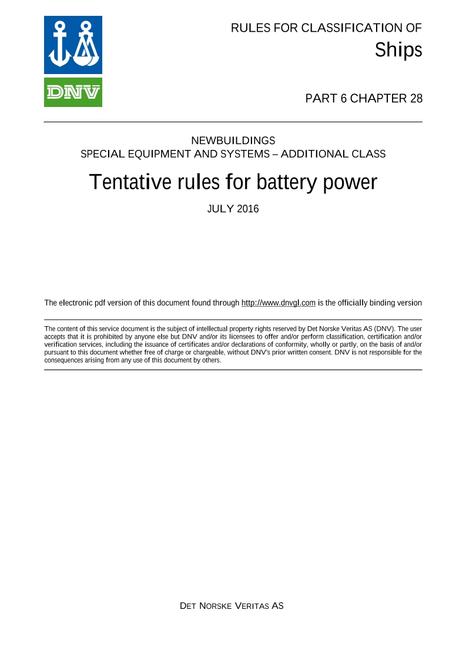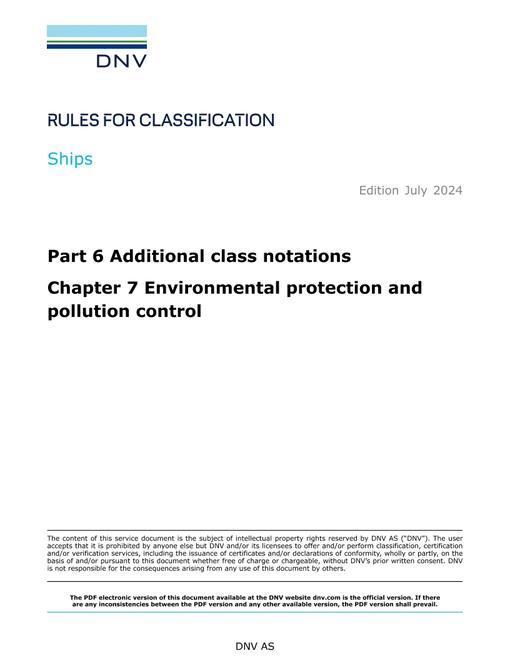-
-
Available Formats
- Availability
- Priced From ( in USD )
-
Available Formats
-
- Secure PDF 🔒
- Immediate download
- $145.00
- Add to Cart
-
- Printed Edition
- Ships in 1-2 business days
- $145.00
- Add to Cart
Customers Who Bought This Also Bought
-

DNV DNV-RP-0661
Priced From $145.00 -

DNV DNV-RU-SHIPS PART 6 CHAPTER 28
Priced From $57.00 -

DNV DNV-RU-SHIPS PART 6 CHAPTER 7
Priced From $57.00
About This Item
Full Description
Application
This standard covers suitable requirements to portable offshore units (POUs), see [1.4.3], with respect to design, manufacturing, testing and certification.
Guidance note 1:
Offshore containers according to the definition in [1.4.4] should always be certified according to DNVGL-ST-E271. Units which are neither portable offshore units nor offshore containers accordingly will not be certified to these standards. In cases where it is not obvious if a design is a portable offshore unit or an offshore container DNV GL will decide whether the design can be certified to DNVGL-ST-E271 or DNVGL-ST-E273 or neither of these.
It is the intention that a POU that is certified by DNV GL according to this standard could be safely sea transported and lifted offshore including subsea (see [3.11]) anywhere in the world. Standardized frames/ skids used for sea transport only may also be certified as a POU, see [3.3.3].
This standard covers the POU’s main structure, supports for any permanent equipment and features important for the functionality during the transport phase.
Guidance note 2:
Structural strength etc. related to the inplace use of e.g. equipment mounted in the POU is not covered.
The intention is that POUs shall meet the following requirements:
Be safe in use with regard to:
— life
— environment
— hazard to the vessel/installation.
Be suitable for single or repeated use in applicable cases through choice of:
— material
— protection, and
— ease of repair and maintenance.
It shall be noted that this standard covers only the POU design and it is the responsibility of the transport/ installation contractor to ensure that all handling is carried out safely with due consideration to applicable HSE requirements.
Users and use of this standard
This standard is primarily issued to help the industry to design and produce POUs that safely can be handled during the transport phase. It is however assumed that all users of this standard have fundamental knowledge within structural engineering and safety discernment. Owners, designers and manufacturers should have a basic understanding of the requirements and limitations outlined in this standard.
The certification scheme described in this document is the scheme used by DNV GL. Organisations other than DNV GL providing certification services related to this standard may also use this scheme or they may use schemes provided by other parties. DNV GL has however no obligations or responsibility for any services related to this standard delivered by others.
DNV GL has a qualification scheme mandatory to approval engineers and surveyors providing services related to this standard. This ensures that all design approvals and certifications delivered are carried out by well qualified personnel who understand the intention behind the standard, the limitations and the correct interpretations.
DNV, DNV GL and their respective logos are trademarks of DNV GL AS and shall not be used without prior permission of DNV GL. This includes, but is not limited to the use of these logos and trademarks in branding services associated with the present standard DNVGLSTE273, e.g. whereas service providers may refer to the standard, also in the form of “2.73”, DNV GL has the exclusive right to brand its services and mark POUs in the form of e.g. “DNV 2.73” and “DNV GL 2.73”.
DNV GL now brands its services in the form of “DNV GL 2.73”. The term “DNV 2.73” is considered synonymous. Adherence to and validity of the preceding paragraph is however unaffected.
Considerations
There are a number of considerations that should be made before establishing design and manufacturing criteria for construction and transport of different types or categories of POUs suitable for transport offshore. Such considerations could be:
— Single or reoccurring transport.
— Value of product may require special design and fabrication precautions.
— Transport phases, e.g. road transport, and transport conditions not adequately covered by the given requirements in this standard.
— Specially planned transport events due to size, shape, weight or other special features.
See [3.1] for design considerations.
Assumptions
The requirements in this standard are based on a number of assumptions regarding the handling and operation of POUs:
A) They are lifted individually by one crane, if not otherwise specified.
B) The maximum allowable wave height during lifting from vessel to/from vessel/platform is restricted according to the POU’s operational class, see [3.3.3].
C) Any wave restriction for subsea lifting, if applicable, needs to be assessed for each POU.
D) The handling/lifting is carried out according to the agreed operational procedure, see [1.2.2], if any, see [1.2.1].
E) The POU is lifted with an adequate lifting set, see e.g. [7.3].
F) They can be lifted anywhere (worldwide) by any crane(s) with sufficient capacity and speed if not otherwise specified, e.g. due to a single transport.
G) They are only stacked if they are designed for this and in this case only onshore or on offshore installations where permitted. Stacking during transport on ships is not covered by this standard, see [1.1.5].
H) Cargo or loose installations are properly secured in the POU.
I) They are handled according to IMO CSS code, OSV code or according to a special made transport procedure.
J) Handling and operation is in accordance with local regulations.
Guidance note:
Local regulations may be stricter than the requirements stated in this standard and should therefore be checked.
Alternative solutions
DNV GL may approve alternative solutions that are found to represent an overall safety standard equivalent to the requirements in this standard. Such approval may be revoked if subsequent information indicates that the chosen alternative is not satisfactory.
Types of portable offshore units
This standard groups the POUs into five types, namely; type A, B, C, D and E. Examples of types A through E are shown in the sketches in Figure 11.
Type A is POUs with a primary structure frame (including skids arranged with crash frames). Type A units typically share many characteristics with offshore containers, but deviate from the definition given in DNVGLSTE271, e.g. with MGW > 25 tonnes or because they are intended for a single transport. POUs which for other reasons are not able to comply with the requirements for containers in DNVGL-STE271 may also be accepted as POUs of type A. Type A units will typically be service packages such as pumps, generation units, coiled tubing units, skid mounted manifolds, pressure vessels or process arrangements of portable nature.
Type B is POUs with skid based installations but without a primary structure frame (skids arranged without crash frames). Type B units could have installations with the same type of main functions as mentioned for type A units. The reason for omitting the crash frame may be related to the size or shape of the POU or other considerations.
Type C is POUs that lack a dedicated skid or frame. Type C units may be arranged with selfsupporting feet, skirts or support points integrated in the units’ own structure. Example of this type could be: xmas trees, reels, manifolds, pressure vessels with stools, etc.
Type D is mainly boxes or units of stress skin design, where the suitability for transport is arranged in the shell through attachments and reinforcements to achieve adequate structural integrity. These types of structures do normally depend on the shell or skin to resist transport generated loads. Examples of the type D POUs would be control cabins or smaller modules for different services.
Guidance note 1:
Units which are intended for repeated offshore transport and lifting without operational restrictions should normally be Offshore Containers according to DNVGL-ST-E271.
Type E is a POU that does neither fall into any of the POU types A through D nor is an offshore container as defined in DNVGL-ST-E271. It shall be agreed with DNV GL in each case if it is applicable to certify a type E unit as a POU.
Guidance note 2:
An example of a possible type E POU could be a tailor made type of lifting tool that is connected to a “cargo”. (The cargo may be some type equipment for offshore use.) The joining between the lifting tool and the “cargo” should be a fixed connection normally by bolts, hydraulic locks or similar. It is only the lifting tool that is considered to be the POU, not the detachable cargo. Example of this type could be: running tools, pullin heads, etc.
Type E POUs are typically used when it is not practical to use either a type C unit, where the load carrying structure of the POU is also the structure of the equipment being transported, or a load carrying skid (type B).
See [3.5.2] for definition of design loads for some type E POUs.
Guidance note 3:
Purpose made lifting tools (e.g. spreaders, yokes or running tools) intended for lifting of an explicitly defined unit can be certified according to DNVGL-ST-E273, either as a type E POU or as part of a lifting set included in the certification of a POU (which is then considered as an integrated part of the POU).
Lifting equipment for general handling of cargo is not covered by DNVGL-ST-E273.
Lifting tools (loose gear) or load carrying accessories to be used in combination with a certain lifting appliance (i.e. crane) should be certified according to DNVGL-ST-0378.
Document History
-
DNV DNV-ST-E273
2.7-3 Portable offshore units- Most Recent
-
DNV DNV-ST-E273
2.7-3 Portable offshore units- Historical Version
-
DNV DNVGL-ST-E273
currently
viewing
2.7-3 Portable offshore units- Historical Version
-
DNV DNVGL-ST-E273
2.7-3 Portable offshore units- Historical Version
-
DNV DNVGL-ST-E273
2.7-3 Portable offshore units- Historical Version




